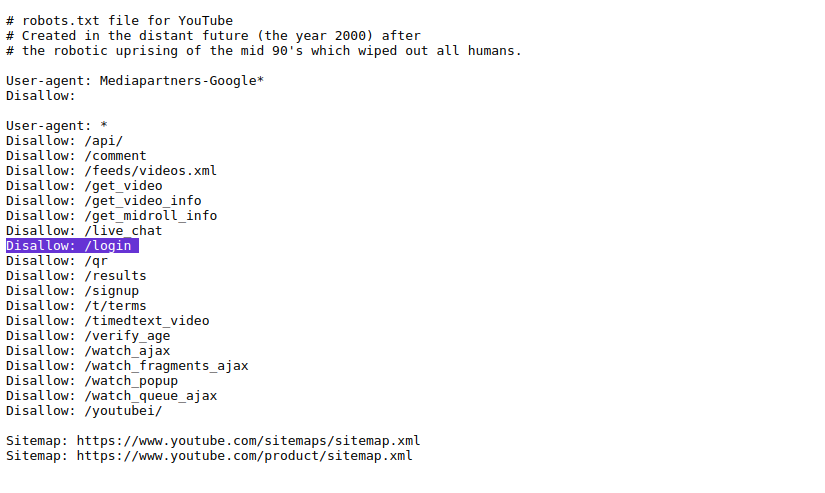Loading...
Loading...
Robots.txt is a simple text file that instructs web crawlers on how to crawl a website and is an important aspect of Search Engine Optimization (SEO). A site owner uses `robots.txt` to effectively guide search engines regarding pages not to be indexed. By doing this, a site owner brings Search Engine Optimization activities under control and prevents the crawling, and indexing of duplicate content and sensitive content.
The Robots Exclusion Protocol, or robots.txt, was invented in 1994 with the idea of providing standard ways for webmasters & crawlers to communicate with one another. Eventually, the standard was taken into account by major search engines such as Google, Bing, and Yahoo!.
The `robots.txt` file must be placed in the root directory of a website. For example, it should be accessible at `https://www.example.com/robots.txt`.
It only takes a few steps to see how `robots.txt` works. Let's take a look:
Step 1: Crawlers Request Access
Step 2: Server Response
Step 3: Parsing the Directives
Step 4: Following the Rules
The crawler decides based on the directives:
Step 5: Indexing Content
Step 6: Maintenance
Finding the `robots.txt` file for any website is very easy. Just follow these simple steps:
1. Open Your Web Browser: Launch any web browser such as Chrome, Firefox, or Safari.
2. Type the Website URL: In the address bar, type in the full URL of the website you want to check. For example, `https://www.example.com`.
3. Add `/robots.txt`: Once you've entered the website URL, add `/robots.txt`at the end of the URL. So now we'd enter `https://www.example.com/robots.txt`.
4. Press Enter: Once you've entered the URL, just press Enter and be taken to that specified URL.
5. View the File: If the website has a `robots.txt` file, it will appear. It will be in plain text. You can now see the directives that the website has put down in the file.
A `robots.txt` file only needs a few steps to create and submit the file. Here is what you need to do:
Step 1: Create the `robots.txt` file
1. Open a Plain Text Editor: There are many plain text editors you can use, including Notepad (Windows), TextEdit (as a plain text file) (Mac), or you could use a code editor like VS Code.
2. Write your directives. Start by writing your `robots.txt` file in the proper syntax. Here are a few examples:
User-agent: *
Disallow: /private/
Allow: /public/
Sitemap: https://www.example.com/sitemap.xml3. Save the File: Save the file as `robots.txt`. Make sure to save it using plain text format (not in Word or any other format).
Step 2: Upload the `robots.txt` File
1. Find Your Website's Root Directory: Use an FTP client (for example FileZilla) or your web hosting's control panel (for example cPanel) to access the files for your website.
2. Go to the Root Directory: This is usually the folder where your website files are located, with the folder title being `public_html` or similar.
3. Upload the File: Drag and drop the `robots.txt` file into the root directory. Make sure it's at the top level and not in one of the subfolders.
Step 3: Verify the `robots.txt` File
1. Open Your Web Browser: You will need to open any web browser.
2. Enter the URL: Write your website url and add `/robots.txt` to the end (for example: `https://www.example.com/robots.txt`)
3. Check That It Displays Correctly: Make sure that the file displays and follows the directives that you wrote.
Step 4: Validate the `robots.txt` File
1. Google Search Console:
- Log in to your Google Search Console account.
- Pick the website property you want to work with.
- Go to "Settings" > "Crawling" > "robots.txt".
- After this, click on open report to test your `robots.txt` file.
2. Bing Webmaster Tools:
- Log in to Bing Webmaster Tools
- Select Your Website Property
- Click on “Tools & Enhancements”>“robots.txt Tester”
- Validate Your robots.txt File
Step 5: Monitor and Update
- Regular Check: Perform an occasional check of your `robots.txt` file to make sure it reflects your current needs.
- Update as Needed: If you change your website structure or content, make changes in the `robots.txt` file as needed and re-upload it.
Example Structure:
User-agent: *
Disallow: /private/
User-agent: the crawler being specified.
Disallow: Indicates which paths should not be accessed.
Directive | Description | Example |
User-agent | Identifies the web crawler | User-agent: Googlebot |
Disallow | Block access to specified paths | Disallow: /private/ |
Allow | Permits access to specific paths | Allow: /public/ |
Crawl-delay | Sets a delay between requests | Crawl-delay: 10 |
Sitemap | Links to the sitemap for better indexing | Sitemap: https://www.example.com/sitemap.xml |
Error | Definition |
Blocking Important Pages | Accidentally disallowing pages that should be indexed. |
Misusing Disallow | Incorrectly blocking entire directories instead of specific files. |
Failing to Test | Not using tools to verify the effectiveness of the file. |
Ignoring User-Agent Specificity | Not considering different crawlers needs. |
- Google Search Console (use for robots.txt validation)
- web server logs (check bots that visited the blocked address)
- Robots.txt checkers (have some online options).
Example
Case Studies:
- Use robots.txt to block specific paths to optimize crawling, e.g.
User-agent: *
Disallow: /gp/cart2. YouTube:
- Disallows user-specific pages to protect privacy.
- Example:
user-agent: *
Disallow: /login
In summary, `robots.txt' is a valuable resource for webmasters to achieve some control of how web crawlers behave. Webmasters who check and frequently update the `robots.txt' file will help enhance the SEO of their websites. As a webmaster, such a basic understanding of the structure and directive values in 'robots.txt' files is essential.